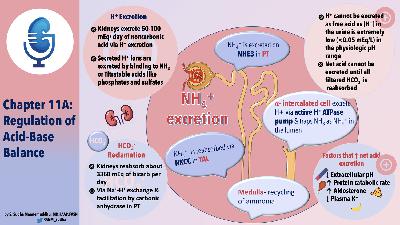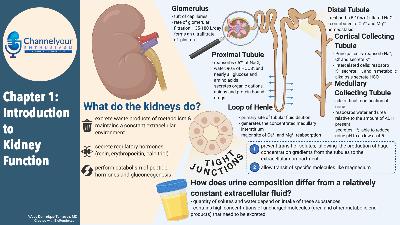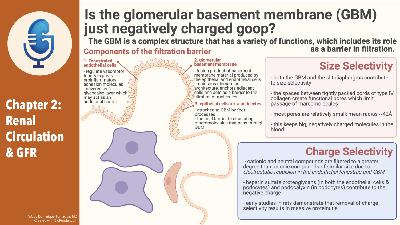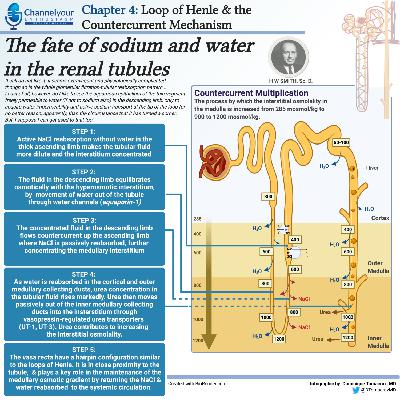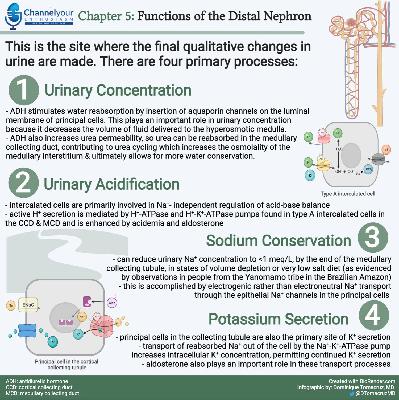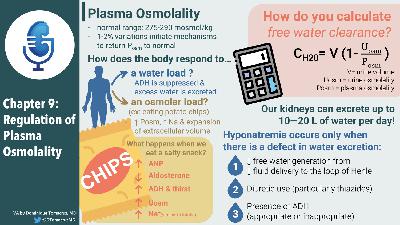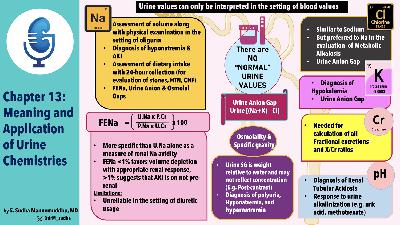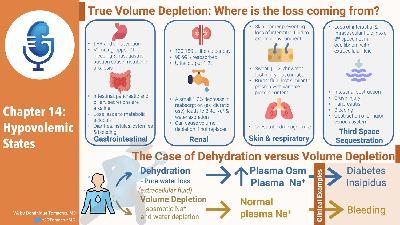Chapter Eleven, part 1: Regulation of Acid-Base Balance
Description
References
We considered the effect of a high protein diet and potential metabolic acidosis on kidney function. This review is of interest by Donald Wesson, a champion for addressing this issue and limiting animal protein: Mechanisms of Metabolic Acidosis-Induced Kidney Injury in Chronic Kidney Disease
Hostetter explored the effect of a high protein diet in the remnant kidney model with 1 ¾ nephrectomy. Rats with reduced dietary acid load (by bicarbonate supplementation) had less tubular damage. Chronic effects of dietary protein in the rat with intact and reduced renal mass
Wesson explored treatment of metabolic acidosis in humans with stage 3 CKD in this study. Treatment of metabolic acidosis in patients with stage 3 chronic kidney disease with fruits and vegetables or oral bicarbonate reduces urine angiotensinogen and preserves glomerular filtration rate
In addition to the effect of metabolic acidosis from a diet high in animal protein, this diet also leads to hyperfiltration. This was demonstrated in normal subjects; ingesting a protein diet had a significantly higher creatinine clearance than a comparable group of normal subjects ingesting a vegetarian diet. Renal functional reserve in humans: Effect of protein intake on glomerular filtration rate.This finding has been implicated in Brenner’s theory regarding hyperfiltration: The hyperfiltration theory: a paradigm shift in nephrology
One of multiple publications from Dr. Nimrat Goraya whom Joel mentioned in the voice over: Dietary Protein as Kidney Protection: Quality or Quantity?
We wondered about the time course in buffering a high protein meal (and its subsequent acid load on ventilation) and Amy found this report:Effect of Protein Intake on Ventilatory Drive | Anesthesiology | American Society of Anesthesiologists
Roger mentioned that the need for acetate to balance the acid from amino acids in parenteral nutrition was identified in pediatrics perhaps because infants may have reduced ability to generate acid. Randomised controlled trial of acetate in preterm neonates receiving parenteral nutrition - PMC
He also recommended an excellent review on the complications of parenteral nutrition by Knochel https://www.kidney-international.org/action/showPdf?pii=S0085-2538%2815%2933384-6 which explained that when the infused amino acids disproportionately include cationic amino acids, metabolism led to H+ production. This is typically mitigated by preparing a solution that is balanced by acetate.
Amy mentioned this study that explored the effect of protein intake on ventilation: Effect of Protein Intake on Ventilatory Drive | Anesthesiology | American Society of Anesthesiologists
Anna and Amy reminisced about a Skeleton Key Group Case from the renal fellow network Skeleton Key Group: Electrolyte Case #7
JC wondered about isolated defects in the proximal tubule and an example is found here: Mutations in SLC4A4 cause permanent isolated proximal renal tubular acidosis with ocular abnormalities
Anna’s Voiceover re: Gastric neobladder → metabolic alkalosis and yes, dysuria. The physiology of gastrocystoplasty: once a stomach, always a stomach but not as common as you might think Gastrocystoplasty: long-term complications in 22 patients
Sjögren’s syndrome has been associated with acquired distal RTA and in some cases, an absence of the H+ ATPase, presumably from autoantibodies to this transporter. Here’s a case report: Absence of H(+)-ATPase in cortical collecting tubules of a patient with Sjogren's syndrome and distal renal tubular acidosis
Can't get enough disequilibrium pH? Check this out- Spontaneous luminal disequilibrium pH in S3 proximal tubules. Role in ammonia and bicarbonate transport.
Acetazolamide secretion was studied in this report Concentration-dependent tubular secretion of acetazolamide and its inhibition by salicylic acid in the isolated perfused rat kidney. | Drug Metabolism & Disposition
In this excellent review, David Goldfarb tackles the challenging case of a A Woman with Recurrent Calcium Phosphate Kidney Stones (spoiler alert, many of these patients have incomplete distal RTA and this problem is hard to treat).
Molecular mechanisms of renal ammonia transport excellent review from David Winer and Lee Hamm.
Outline
Outline: Chapter 11
- Regulation of Acid-Base Balance
- Introduction
- Bicarb plus a proton in equilibrium with CO2 and water
- Can be rearranged to HH
- Importance of regulating pCO2 and HCO3 outside of this equation
- Metabolism of carbs and fats results in the production of 15,000 mmol of CO2 per day
- Metabolism of protein and other “substances” generates non-carbonic acids and bases
- Mostly from sulfur containing methionine and cysteine
- And cationic arginine and lysine
- Hydrolysis of dietary phosphate that exists and H2PO4–
- Source of base/alkali
- Metabolism of an ionic amino acids
- Glutamate and asparatate
- Organic anions going through gluconeogenesis
- Glutamate, Citrate and lactate
- Net effect on a normal western diet 50-100 mEq of H+ per day
- Homeostatic response to these acid-base loads has three stages:
- Chemical buffering
- Changes in ventilation
- Changes in H+ excretion
- Example of H2SO4 from oxidation of sulfur containing AA
- Drop in bicarb will stimulate renal acid secretion
- Nice table of normal cid-base values, arterial and venous
- Great 6 bullet points of acid-base on page 328
- Kidneys must excrete 50-100 of non-carbonic acid daily
- This occurs by H secretion, but mechanisms change by area of nephron
- Not excreted as free H+ due to minimal urine pH being equivalent to 0.05 mmol/L
- No H+ can be excreted until virtually all of th filtered bicarb is reabsorbed
- Secreted H+ must bind buffers (phosphate, NH3, cr)
- PH is main stimulus for H secretion, though K, aldo and volume can affect this.
- Renal Hydrogen excretion
- Critical to understand that

